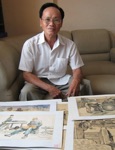Copyright © 1986-2016, Witness Collection and other copyright holders. All rights reserved.
Images and content on this site may not be reproduced in any form without prior written consent from Witness Collection.
For information about exhibitions, loans, internships or other forms of collaboration, please email us via the contact us page.

Minh’s family supported the resistance forces in the anti-colonial war against France and in the anti-American war. His grandfather was village head (Hương Cả). His family gradually sold their land to support the resistance force. Two of Minh’s brothers and his youngest sister died as war heroes (liệt sỹ). His mother was later awarded the title of ‘Vietnamese Heroic Mother’ (Bà mẹ Việt Nam anh hùng).
In 1947, while still 10 years old, Minh volunteered to join the resistance at Vĩnh Lợi revolutionary base in Bình Dương province, following two elder brothers who had joined previously. He was tasked with delivering documents and mail, as well as printing by hand. Soon known for his beautiful hand-writing, he was assigned to transcribe official letters and directives. At the base, he attended some short-term drawing classes. In 1954, he left the base to travel by boat to Hanoi to join a programme to train future revolutionary cadres.
While in Hanoi, Minh attended art classes under Diệp Minh Châu, a lecturer from Vietnam Fine Art College. To qualify to take the entrance exam to study at the college, it was necessary to first obtain a certificate of precollege fine art (Trung cấp Mỹ thuật) and gain three years’ work experience. Although already qualified to take entrance exams to become a teacher, Minh followed Diệp Minh Châu’s advice and sacrificed nearly six years to prepare for what he most loved. In 1959, he enrolled in the intermediate course, graduating in 1962. He was then assigned to a drawing cadre with the Department of Culture in the northwest, spending much of his time among the diverse ethnic groups of the mountainous region.
In 1965, Minh finally met the requirements to enroll at Vietnam Fine Art College, where he joined the lacquer department. Due to the cost and scarcity of materials (such as gold and silver leaf and lacquer itself), there were only a handful of students studying lacquer. Minh chose lacquer due to the long lacquer-making tradition that existed in his home province. His teacher was Hoàng Tích Chù. Materials were so scarce that for oil painting, students used the fabric from Cuban sugar sacks for their canvases; some were already painted on one side by another student.
During their studies at Vietnam Fine Art College, students were divided into small groups to spent three months each year on field trips to places such as farms, factories or mines. Students would live, work, eat and stay with labourers to learn about the workers’ lives before creating art works to be graded back at college. In 1967 and 1968, Minh went to Thanh Hóa province (approximately 140km south of Hanoi) on these trips, during the first year staying with artillery units protecting the famous Dragon’s Jaw Bridge (Cầu Hàm Rồng), the following year staying at a cooperative fishery at Hoàng Trường in Hoa Lộc commune.
After graduating from Vietnam Fine Art College in 1970, Minh took up various teaching roles before returning to the south of Vietnam after war ended in 1975, where he became a lecturer at Ho Chi Minh City Fine Art University and subsequently its Vice President until he left in 1988. He retired in 1997 but continued as a guest lecturer at several universities.
Nguyễn Thanh Minh
